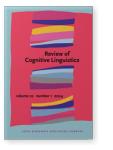Vol. 22:1 (2024) ► pp.151–203
Capturing meaningful generalizations at varying degrees of resolution
The case of the family of ser muy de-PP constructions in present-day Spanish
This article provides a principled constructionist account (Goldberg & Herbst, 2021) of the main characteristics of expressions like the following: (1) Juan es muy de (ir de) bares (‘Juan is very into (going to) bars’), and (2) Tu ayuda es muy de agradecer (‘Your help is very much appreciated’). Instances of this kind are best handled in terms of coercion between the intensifier and non-stative/non-gradable elements in the nominal slot of the de-PPs. Specifically, these combinations qualify as individual-level predicates with a characterizing, evaluative interpretation. The specific constructional interpretations in (1)–(2) arise from contextual adjustments (Carston, 2015), encoding a person’s habits and a potential modal deontic habituality, respectively. The semantic and pragmatic properties of the sub-constructions in (1)–(2), among others, can be adequately subsumed under a family of ser muy de-PP constructions, with the following general meaning: ‘X (SOMEONE/SOMETHING) (SUBJECT) IS SUBJECTIVELY CONSTRUED AS HAVING Y (A HIGHLIGHTED CLASSIFICATORY PROPERTY OF AN INDIVIDUAL/CLASS) (ATTRIBUTE)’.
Article outline
- 1.Introduction
- 2.The semantic and pragmatic contribution of the ser muy de-PP constructions
- 3.Subjectivity, construal, pragmatic adjustment and linguistic cueing
- 4.An overview of the different morphosyntactic realizations of ser muy de-PP constructions in present-day Spanish
- 5.The ser muy de-PP construction with bare nouns, NPs with a definite determiner and NPs with an indefinite determiner
- 6.The ser muy de-PP construction with active infinitival complement clauses
- 7.The ser muy de-PP construction with a que- (‘that’-) complement clause construction
- 8.The modal/evaluative construction with a passive infinitival complement clause
- 9.Outlook and closing remarks
- Acknowledgements
- Notes
-
References
